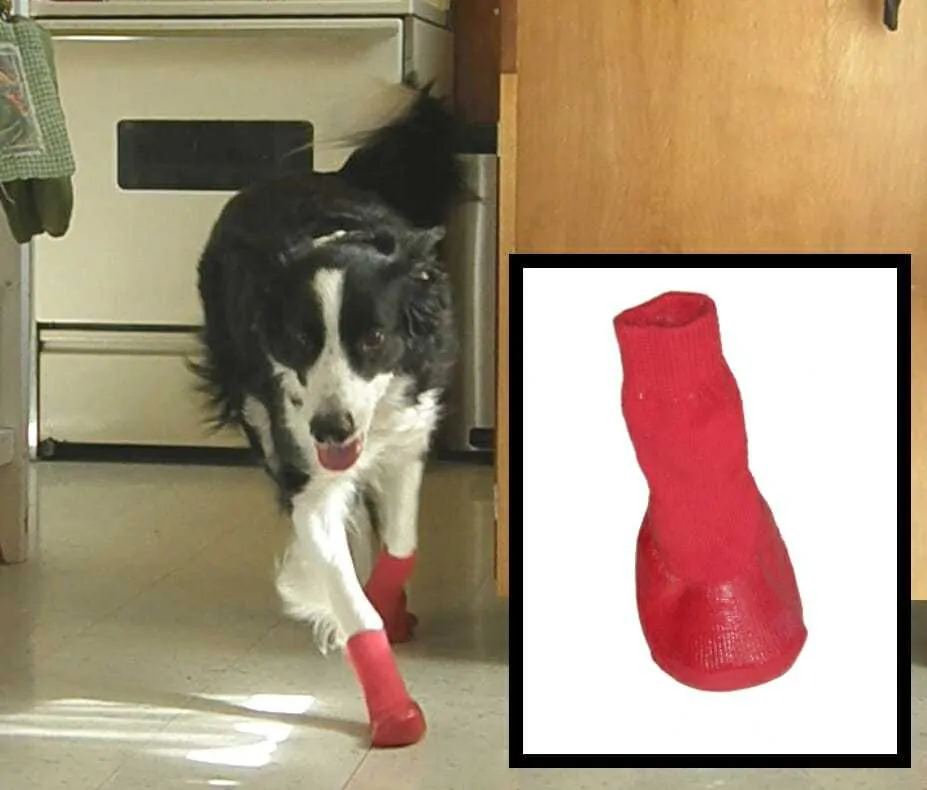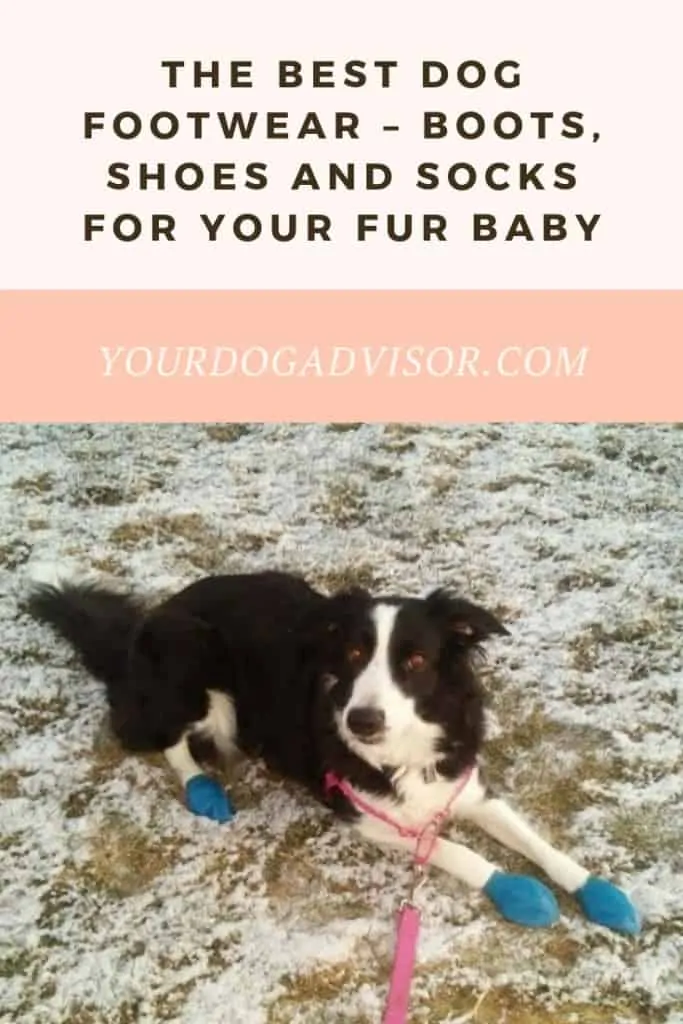We’ve all seen celebs trot out their pooches in designer label outfits complete with matching booties. So as a pet parent, you may be wondering: Do dogs really need boots? The short answer is yes. Like our own footwear, dog boots offer protection to our canine companion’s paws.
So what is the best dog footwear? If you’ve been shopping for shoes, you may be surprised at the selection. Just like in human shoe departments, dog footwear comes in a variety of shapes, styles and fabrics. Some features, like the color or print of the fabric, are strictly a personal choice. Others are key factors to consider when selecting protective footwear for your fur baby.
Canine footgear can be adorable. It also serves a useful purpose. Finding a product that works best for you starts with deciding how booties can benefit your four-legged companion.
Why Do Dogs Wear Boots?
There are many ways dog footwear benefit our furry friends. Here are some you might consider:
Protection from the cold: If you’ve been using a sweater or coat to keep your baby warm during winter bathroom breaks, consider adding a set of fur-lined boots. They can provide an insulating layer between the sub-freezing ground and those bare paw pads. Just like human skin, paws can get frostbite when ground surface temperatures fall below freezing.
Protection from wet: Snow and ice can stick to the fur on our bestie’s paws and pack between the toes, making them uncomfortable. Salt can irritate your pup’s feet. Wet paws are also more susceptible to frostbite. Waterproof boots can keep our best buddy’s feet warm and dry.
Protection from hot pavement: Summer sun can make asphalt too hot for our four-legged friends. Paved parking lots and crosswalks can cause serious burns, even when the ambient temperature is in the seventies. Thick-soled sandals can make walking on pavement safer and more comfortable for your furry friend. ETbotu makes a breathable sandals have mesh uppers to prevent puppy paws from overheating during midday walks. The rubber soles are also anti-skid to prevent slippage.
[amazon box=”B07D4K2GCS” style=”light” title=”Breathable Puppy Sandals” template=”widget”]
Protection from injury: Roadsides, parking lots and even public pathways can be littered with broken glass, sharp rocks or even discarded needles. Don’t think escaping to nature is the answer. Hiking on wooded trails can have splintery sticks and thorns. Hard-soled shoes can prevent cuts and punctures to paw pads when walking on these surfaces.
Prevents spread of disease: Hookworms are an internal parasite that can be spread when dogs walk on contaminated soil and pick up the larvae on their feet. Frequenting dog parks, staying in dog-friendly hotels and using pet areas at rest stops can increase your pooch’s exposure to these parasites, as well as other fecal-borne diseases. Footwear can give your best friend an added layer of protection.
Prevents infection: If your best buddy gets a cut on his paw or is recovering from surgery on his feet, non-skid socks can protect the injury or sutures.
Cushions bed sores: Older or convalescing canines often develop bed sores from laying on hard surfaces. Non-skid socks can cushion these sores and help promote healing.
Socks have non-skid patches on the sole or like this set, the entire bottom of the sock is dipped in rubber. Socks are ideal for indoor use on slippery floors.
Prevent slipping: Hardwood, tile and vinyl flooring are slippery surfaces for playful pups. Non-skid socks can give them better traction and prevent injuries.
Keeps floors and carpets cleaner: Dog footgear does more than protect your pet. Mud-resistant boots can keep your floors cleaner by preventing your pooch from tracking mud and dirt into your home.
Prevents scratched floors: We all love our fur kids, but being a pet parent doesn’t mean giving up beautiful flooring. Non-skid socks can prevent sharp nails from scratching our hardwood and delicate floors.
What Are the Best Dog Boots?
For me, the best canine footgear is easy to put on and stay on my fur baby’s feet. I prefer Pawz waterproof boots for quick bathroom breaks in muddy or wet weather.
Canine footgear can range from flat mitten-type garments to form-fitting precision-crafted footwear. They can be totally utilitarian or cute and whimsical. They can slip on, strap on or tie with shoelaces. So which styles will work for you? It’s often a matter of personal choice, but here are features worth considering when shopping for your best friend’s next set of footwear:
Ease of Use: Stretchy types of footwear slip over your pooch’s paws, while those with a rigid construction require the paw to be gently pushed down into the boot. The latter style often requires straps or fasteners to stay in place. I find these types take more skill and coordination to use than stretchy styles.
Staying Power: Footwear that falls off easily is more than an inconvenience. They can’t protect your pup’s paws if they’re in your pocket for most of the walk. You’re also more likely to lose a shoe that doesn’t stay put. And let’s face it, how useful is a set of three shoes?
Durability: Naturally, we want our best friend’s footgear to last a long time, especially if they were expensive. It’s prudent to check the general construction. Does the stitching seem strong? Are the straps firmly attached? Will the Velcro ® fasteners fill with hair and lose their hold?
Correct size: Be sure to follow the manufacturer’s guide for sizing footwear. Shoes that are too large won’t stay put, while too-small shoes can pinch your pup’s toes.
Waterproof vs. water repellent: Waterproof boots are impervious to water, while water repellent or water resistant means the footwear can eventually absorb water and leave your pooch’s paws wet and soggy.
Breathable: Although canines primarily cool themselves by panting, they have sweat glands located in their paws. Breathable fabric uppers on shoes allow for the evaporation of this sweat.
Reflective: Glow-in-the-dark stripes or LED lights are ideal for nighttime walks. They make your precious pup more visible to traffic and could save his life. If you’re looking for protection in the form of improved visibility, Kurgo Step and Strobe dog shoes have both red and green LED lights and 360° reflective piping. The LED lights are powered by battery, which is not replaceable. The battery is sealed for water resistant use and comes with a one year guarantee.
[amazon box=”B00IT09T3W” style=”light” title=”Kurgo Step N Strobe” template=”widget”]
Ease of Cleaning: Dirty footwear can become stiff. They can be hard to put on your best friend and they can cause sores when they rub against his skin. Shoes that resist stains or can be tossed in the laundry means more time to play with your fur kid.
Price: Canine footwear ranges in price from a few dollars to more than dinner in a fancy restaurant. Try shopping off-season for the best deals.
Function over fashion: With so many adorable shoes on the market, it can be easy to lose sight of the objective. Just make sure the footgear you’ve fallen in love with is designed to offer the protection you want.
Pet parents who are looking for both style and functionality might find Glumes Lace Up Dog Shoes a good choice. Patterned after human sneakers, Glumes are reasonably priced and features canvas uppers (also available in navy blue) and non-skid soles.
[amazon box=”B07Q7FWPJB” style=”light” title=”Glumes lace up boots” template=”widget”]
How Do I Get my Dog to Wear Boots?
We’ve all seen funny YOUtube videos of boot-wearing pooches lifting their feet high in the air and walking in an exaggerated fashion. This is understandable – shoes probably feel very funny to your four-legged friend. The following tips can help your fur baby acclimate to wearing them.
Start slow: Soft, flexible footwear, like socks, are the easiest to put on and the least likely to cause disruption in your pup’s ability to walk. Try using a pair of inexpensive socks before progressing to a set of rigid footwear.
Keep your dog calm: You’ll find it helpful to put a leash on your pooch before putting on any type of footwear. It’ll keep your bestie within your reach, where you can watch his reaction and calm him if necessary.
Handle paws gently: Canine paws are one of the more sensitive areas of the body. At first, it’ll be normal for your pup to resist any effort to put on their shoes. It’s all too easy to squeeze those tiny toes too tightly or pull too hard on the hip or elbow joints.
Play with your dog: Make boot-time fun-time. Once you have those shoes on your pup, give him a treat, play fetch or distract him with lots of love.
Start early: Don’t wait until the middle of a blizzard to decide your bestie needs protection. Give yourself time to learn to put footgear on easily and give your fur baby time to adjust to wearing them.
Keep your dog’s nails trimmed: Long nails can snag on the inside of the boots and pull the toes in the wrong direction, causing your pal pain or possibly breaking a toe.
Stand at different levels: It’s helpful to have your fur baby at a comfortable working height. For me, this means standing a few steps down with my buddy at the top of the stairs. Toy breeds can be placed on a table.
Use the “Stand” cue: If your tail-wagger doesn’t know how to stand still, try getting in a few training sessions before you need to put shoes on your pup.
Practice, Practice, Practice: Use footgear regularly, especially at first. The more practice you have putting boots on your fur baby, the easier it will be for you to do so quickly and the more patient your best friend will become.

Jen Jones is a professional dog trainer and behavior specialist with more than 25 years of experience. As the founder of ‘Your Dog Advisor’ and the ‘Canine Connection’ rehabilitation center, she applies a holistic, empathetic approach, aiming to address root causes rather than merely treating symptoms.
Well known for her intuitive and compassionate approach, Jen adopts scientifically-proven, reward-based methods, encouraging positive reinforcement over punishment. Jen specializes in obedience training, behavior modification, and puppy socialization. Her innovative methods, particularly in addressing anxiety and aggression issues, have been widely recognized. Jen has worked with many of the world’s leading dog behaviorists and in her free time volunteers with local animal shelters and rescue groups.



